Experimental and Simulation Research on Femtosecond Laser Induced Controllable Morphology of Monocrystalline SiC
Abstract
:1. Introduction
2. Theoretical Model
2.1. Principle Description
2.2. Carrier Density and Laser Source
2.3. Boundary Conditions
2.4. Modeling Process
3. Experimental Procedures
4. Results and Discussion
4.1. Ablation Geometrical Characteristics Validation
4.2. Analysis of Ablation Geometrical Morphology under Different Parameters
4.3. Analysis of Carrier Density Alterations
5. Conclusions
- (1)
- The experimental results verified that the model could accurately predict the ablation morphology considering alterations in carrier density during the ablation of SiC. The predicted errors of ablation diameter and depth within a specific range were controlled within 7.44% and 6.94%, respectively. The multi-physics field model developed in this work can be used to establish the quantitative relationship between the ablation morphology and the laser power.
- (2)
- The removal mechanism during the ablation of SiC was analyzed. Multiphoton absorption is thought to be the primary energy deposition mechanism in femtosecond ablation. The deposition of laser pulses and heat conduction induce a very strong thermal effect on the material surface.
- (3)
- The response relationship analysis of the nonlinear alteration in optical as well as physical parameters and the ablation morphology was developed. The carrier density alterations directly affect the electron-lattice coupling coefficient, resulting in lattice temperature redistribution. As the carrier density increases, the temperature rises rapidly, leading to an increase in the ablation depth and diameter.
Author Contributions
Funding
Data Availability Statement
Conflicts of Interest
References
- She, X.; Huang, A.Q.; Lucia, O.; Ozpineci, B. Review of silicon carbide power devices and their applications. IEEE Trans. Ind. Electron. 2017, 64, 8193–8205. [Google Scholar] [CrossRef]
- Zhai, Z.; Wang, W.; Mei, X.; Li, M.; Cui, J.; Wang, F.; Pan, A. Effect of the surface microstructure ablated by femtosecond laser on the bonding strength of EBCs for SiC/SiC composites. Opt. Commun. 2018, 424, 137–144. [Google Scholar] [CrossRef]
- Huang, Y.; Zhou, Y.; Li, J.; Zhu, F. Femtosecond laser surface modification of 4H-SiC improves machinability. Appl. Surf. Sci. 2023, 615, 156436. [Google Scholar] [CrossRef]
- Zheng, Q.; Mei, X.; Jiang, G.; Yan, Z.; Fan, Z.; Wang, W.; Pan, A.; Cui, J. Influence of surface morphology and processing parameters on polishing of SiC ceramics using femtosecond laser pulses. Surf. Interfaces 2023, 36, 102528. [Google Scholar] [CrossRef]
- Hu, B.; Gonzalez, J.O.; Ran, L.; Ren, H.; Zeng, Z.; Lai, W.; Gao, B.; Alatise, O.; Lu, H.; Bailey, C.; et al. Failure and reliability analysis of a SiC power module based on stress comparison to a Si device. IEEE Trans. Device Mater. Reliab. 2017, 17, 727–737. [Google Scholar] [CrossRef]
- Wang, H.-J.; Yang, T. A review on laser drilling and cutting of silicon. J. Eur. Ceram. Soc. 2021, 41, 4997–5015. [Google Scholar] [CrossRef]
- Yang, L.; El-Tamer, A.; Hinze, U.; Li, J.; Hu, Y.; Huang, W.; Chu, J.; Chichkov, B.N. Parallel direct laser writing of micro-optical and photonic structures using spatial light modulator. Opt. Lasers Eng. 2015, 70, 26–32. [Google Scholar] [CrossRef]
- Li, L.; Wang, P.; Hu, Y.; Lin, G.; Wu, Y.; Huang, W.; Zhao, Q. Novel carbazole derivatives with quinoline ring: Synthesis, electronic transition, and two-photon absorption three-dimensional optical data storage. Spectrochim. Acta Part A Mol. Biomol. Spectrosc. 2015, 139, 243–252. [Google Scholar] [CrossRef]
- Somiya, S.; Inomata, Y. Silicon Carbide Ceramics. 1. Fundamental and Solid Reaction; Elsevier Applied Science: London, UK, 1991. [Google Scholar] [CrossRef]
- Salvatori, S.; Ponticelli, G.S.; Pettinato, S.; Genna, S.; Guarino, S. High-pressure sensors based on laser-manufactured sintered silicon carbide. Appl. Sci. 2020, 10, 7095. [Google Scholar] [CrossRef]
- Shi, Y.; Sun, Y.; Liu, J.; Tang, J.; Li, J.; Ma, Z.; Cao, H.; Zhao, R.; Kou, Z.; Huang, K.; et al. UV nanosecond laser machining and characterization for SiC MEMS sensor application. Sens. Actuators A Phys. 2018, 276, 196–204. [Google Scholar] [CrossRef]
- Chen, J.; An, Q.; Ming, W.; Chen, M. Investigations on continuous-wave laser and pulsed laser induced controllable ablation of SiCf/SiC composites. J. Eur. Ceram. Soc. 2021, 41, 5835–5849. [Google Scholar] [CrossRef]
- Zhang, R.; Huang, C.; Wang, J.; Zhu, H.; Yao, P.; Feng, S. Micromachining of 4H-SiC using femtosecond laser. Ceram. Int. 2018, 44, 17775–17783. [Google Scholar] [CrossRef]
- Zhai, Z.; Wei, C.; Zhang, Y.; Cui, Y.; Zeng, Q. Investigations on the oxidation phenomenon of SiC/SiC fabricated by high repetition frequency femtosecond laser. Appl. Surf. Sci. 2020, 502, 144131. [Google Scholar] [CrossRef]
- Xie, X.; Peng, Q.; Chen, G.; Li, J.; Long, J.; Pan, G. Femtosecond laser modification of silicon carbide substrates and its influence on CMP process. Ceram. Int. 2021, 47, 13322–13330. [Google Scholar] [CrossRef]
- Zhang, X.; Chen, X.; Chen, T.; Ma, G.; Zhang, W.; Huang, L. Influence of Pulse Energy and Defocus Amount on the Mechanism and Surface Characteristics of Femtosecond Laser Polishing of SiC Ceramics. Micromachines 2022, 13, 1118. [Google Scholar] [CrossRef]
- Li, G.; Li, J.; Yang, L.; Li, X.; Hu, Y.; Chu, J.; Huang, W. Evolution of aluminum surface irradiated by femtosecond laser pulses with different pulse overlaps. Appl. Surf. Sci. 2013, 276, 203–209. [Google Scholar] [CrossRef]
- Ren, Y.; Chen, J.; Zhang, Y. Modeling of ultrafast phase alterations in metal films induced by an ultrashort laser pulse using a semi-classical two-temperature model. Int. J. Heat Mass Transf. 2012, 55, 1620–1627. [Google Scholar] [CrossRef]
- Chen, C.; Zhang, F.; Zhang, Y.; Xiong, X.; Ju, B.-F.; Cui, H.; Chen, Y.-L. Single-pulse femtosecond laser ablation of monocrystalline silicon: A modeling and experimental study. Appl. Surf. Sci. 2021, 576, 151722. [Google Scholar] [CrossRef]
- Lin, G.; Ji, P.; Wang, M.; Meng, Y. Numerical insight into heat transfer in surface melting and ablation subject to femtosecond laser processing aluminum. Int. Commun. Heat Mass Transf. 2023, 142, 106649. [Google Scholar] [CrossRef]
- Wang, X.; Ye, X.; Yao, H.; Wei, P.; Yin, F.; Cong, J.; Tong, Y.; Zhang, L.; Zhu, W. Simulation of femtosecond laser ablation and spallation of titanium film based on two-temperature model and molecular dynamics. J. Laser Appl. 2021, 33, 012047. [Google Scholar] [CrossRef]
- Wu, Y.; Kong, L.; Chen, Y.; Tong, Y.; Liang, X. Femtosecond laser melting NbMoTaW refractory high entropy alloy: A micro-scale thermodynamic simulation. Appl. Surf. Sci. 2023, 613, 155997. [Google Scholar] [CrossRef]
- Zhang, T.; Zhang, L.; Zhang, C.; Chen, X.; Li, J. Physical study of spatter and melt pool dynamics during millisecond laser metals drilling. Opt. Commun. 2021, 482, 126627. [Google Scholar] [CrossRef]
- Wang, M.; Mei, W.; Wang, Y. Simulation of femtosecond laser ablation sapphire based on free electron density. Opt. Laser Technol. 2019, 113, 123–128. [Google Scholar] [CrossRef]
- An, H.; Wang, J.; Fang, F. Material removal on silicon towards atomic and close-to-atomic scale by infrared femtosecond laser. Mater. Sci. Semicond. Process. 2023, 158, 107368. [Google Scholar] [CrossRef]
- Zhai, Z.; Wang, W.; Zhao, J.; Mei, X.; Wang, K.; Wang, F.; Yang, H. Influence of surface morphology on processing of C/SiC composites via femtosecond laser. Compos. Part A Appl. Sci. Manuf. 2017, 102, 117–125. [Google Scholar] [CrossRef]
- Zhou, Y.; Wu, D.; Luo, G.; Hu, Y.; Qin, Y. Efficient modeling of metal ablation irradiated by femtosecond laser via simplified two-temperature model coupling molecular dynamics. J. Manuf. Process. 2022, 77, 783–793. [Google Scholar] [CrossRef]
- Yang, L.; Li, J.; Hu, Y.; Zhang, C.; Lao, Z.; Huang, W.; Chu, J. Projection two-photon polymerization using a spatial light modulator. Opt. Commun. 2014, 331, 82–86. [Google Scholar] [CrossRef]
- Darkins, R.; Duffy, D.M. Modelling radiation effects in solids with two-temperature molecular dynamics. Comput. Mater. Sci. 2018, 147, 145–153. [Google Scholar] [CrossRef]
- Taylor, L.L.; Scott, R.E.; Qiao, J. Integrating two-temperature and classical heat accumulation models to predict femtosecond laser processing of silicon. Opt. Mater. Express 2018, 8, 648–658. [Google Scholar] [CrossRef]
- Guo, J.; Ji, P.; Jiang, L.; Lin, G.; Meng, Y. Femtosecond laser sintering Al nanoparticles: A multiscale investigation of combined molecular dynamics simulation and two-temperature model. Powder Technol. 2022, 407, 117682. [Google Scholar] [CrossRef]
- Saghebfar, M.; Tehrani, M.K.; Darbani, S.M.R.; Majd, A.E. Femtosecond pulse laser ablation of chromium: Experimental results and two-temperature model simulations. Appl. Phys. A Mater. 2017, 123, 28. [Google Scholar] [CrossRef]
- Boyd, G.D.; Kleinman, D.A. Parametric Interaction of Focused Gaussian Light Beams. J. Appl. Phys. 1968, 39, 3597–3639. [Google Scholar] [CrossRef]
- Chen, J.; Tzou, D.; Beraun, J. A semiclassical two-temperature model for ultrafast laser heating. Int. J. Heat Mass Transf. 2006, 49, 307–316. [Google Scholar] [CrossRef]
- Zhang, Y.; Dou, X.; Li, F.; Sun, X. The response characteristics of avalanche photodiodes to ultrashort pulsed laser. Infrared Phys. Technol. 2015, 73, 226–231. [Google Scholar] [CrossRef]
- Deng, Y.; Zhou, Y.; Zhang, Y.; Chen, D.; Zhou, X. Numerical and experimental analysis of nanosecond laser ablation of SiC. Mater. Sci. Semicond. Process. 2022, 151, 107020. [Google Scholar] [CrossRef]
- Zhang, J.; Chen, Y.; Hu, M.; Chen, X. An improved three-dimensional two-temperature model for multi-pulse femtosecond laser ablation of aluminum. J. Phys. 2015, 117, 063104. [Google Scholar] [CrossRef]
- Wei, R.; Song, S.; Yang, K.; Cui, Y.; Peng, Y.; Chen, X.; Hu, X.; Xu, X. Thermal conductivity of 4H-SiC single crystals. J. Appl. Phys. 2013, 113, 053503. [Google Scholar] [CrossRef]
- Duc, D.H.; Naoki, I.; Kazuyoshi, F. A study of near-infrared nanosecond laser ablation of silicon carbide. Int. J. Heat Mass Transf. 2013, 65, 713–718. [Google Scholar] [CrossRef]
- Bulgakova, N.; Bulgakov, A. Pulsed laser ablation of solids: Transition from normal vaporization to phase explosion. Appl. Phys. A 2001, 73, 199–208. [Google Scholar] [CrossRef]
- Rehman, Z.; Janulewicz, K. Structural transformations in femtosecond laser-processed n-type 4H-SiC. Appl. Surf. Sci. 2016, 385, 1–8. [Google Scholar] [CrossRef]
- Le Harzic, R.; Breitling, D.; Weikert, M.; Sommer, S.; Dausinger, F.; Valette, S.; Donnet, C.; Audouard, E.; Föhl, C. Ablation comparison with low and high energy densities for Cu and Al with ultra-short laser pulses. Appl. Phys. A 2005, 80, 1589–1593. [Google Scholar] [CrossRef]
- Liu, Y.; Ding, Y.; Xie, J.; Xu, L.; Jeong, I.W.; Yang, L. One-Step Femtosecond Laser Irradiation of Single-Crystal Silicon: Evolution of Micro-Nano Structures and Damage Investigation. Mater. Des. 2023, 225, 111443. [Google Scholar] [CrossRef]
- Tangwarodomnukun, V.; Wang, J.; Huang, C.; Zhu, H. Heating and material removal process in hybrid laser-waterjet ablation of silicon substrates. Int. J. Mach. Tools Manuf. 2014, 79, 1–16. [Google Scholar] [CrossRef]
- Cheng, C.; Xu, X. Mechanisms of decomposition of metal during femtosecond laser ablation. Phys. Rev. B 2005, 72, 165415. [Google Scholar] [CrossRef]
- Herrmann, M.; Schönfeld, K.; Klemm, H.; Lippmann, W.; Hurtado, A.; Michaelis, A. Laser-supported joining of SiC-fiber/SiCN ceramic matrix composites fabricated by precursor infiltration. J. Eur. Ceram. Soc. 2014, 34, 2913–2924. [Google Scholar] [CrossRef]
- Yan, Z.; Lin, Q.; Li, G.; Zhang, Y.; Wang, W.; Mei, X. A combined model for formation mechanism of ripples induced by femtosecond laser on silicon carbide. Appl. Phys. A 2020, 126, 915. [Google Scholar] [CrossRef]
- Wu, C.; Fang, X.; Kang, Q.; Sun, H.; Zhao, L.; Tian, B.; Fang, Z.; Pan, M.; Maeda, R.; Jiang, Z. Crystal cleavage, periodic nanostructure and surface modification of SiC ablated by femtosecond laser in different media. Surf. Coatings Technol. 2021, 424, 127652. [Google Scholar] [CrossRef]
- Cai, X.; Ji, C.; Wang, Z.; Wang, S.; Pan, J.; Lei, C.; Liu, S. Ultrafast processes simulation under femtosecond laser irradiation of Gallium Nitride thin films. Comput. Mater. Sci. 2022, 214, 111627. [Google Scholar] [CrossRef]

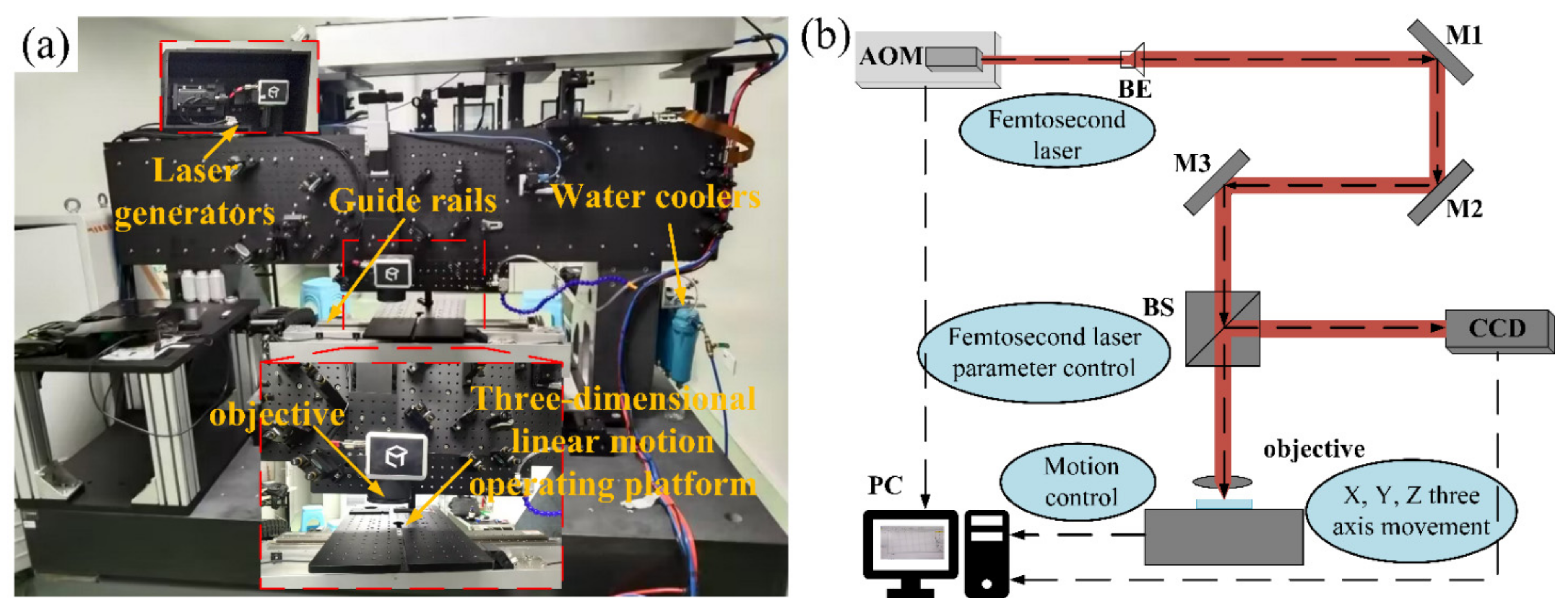


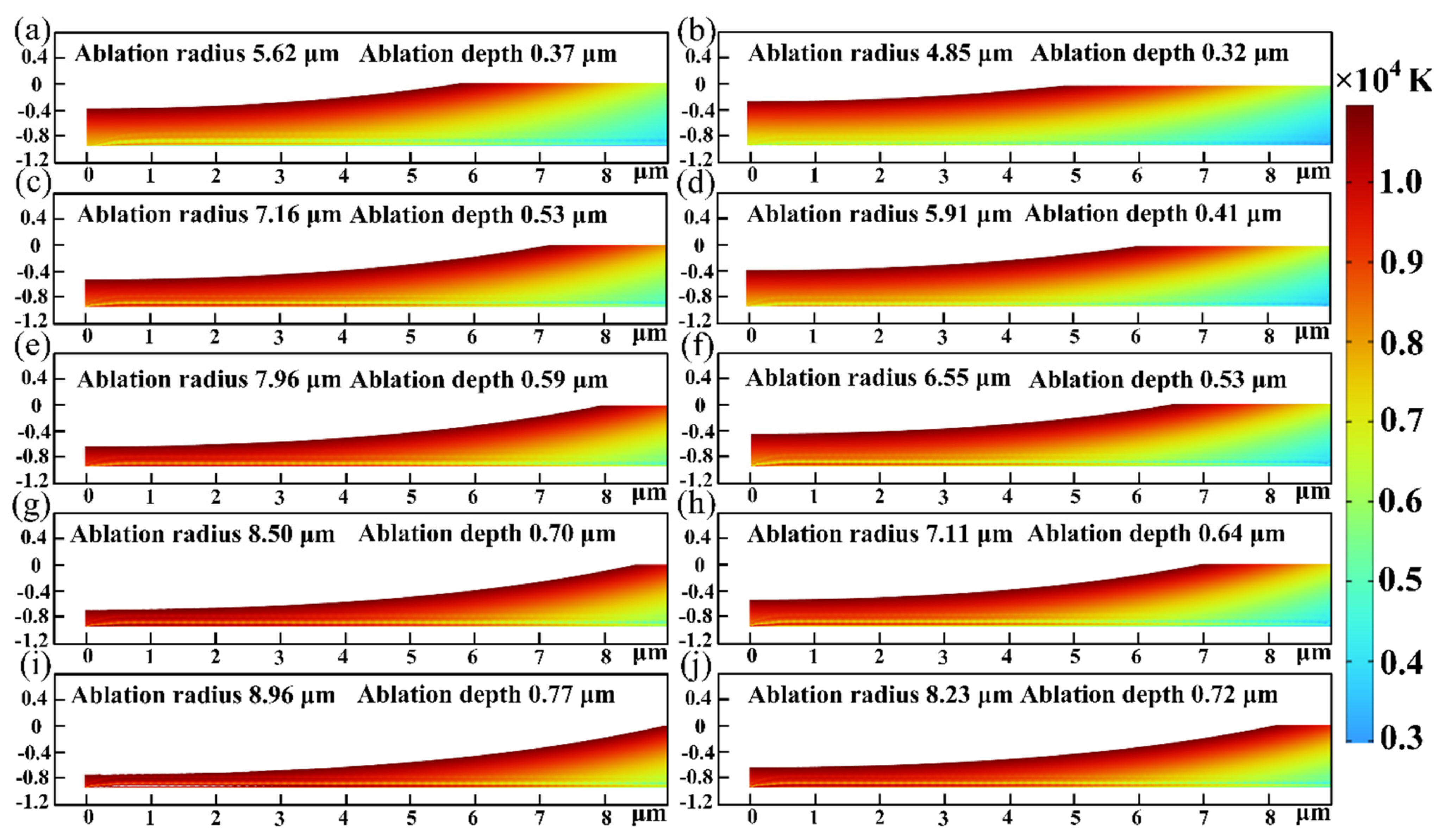
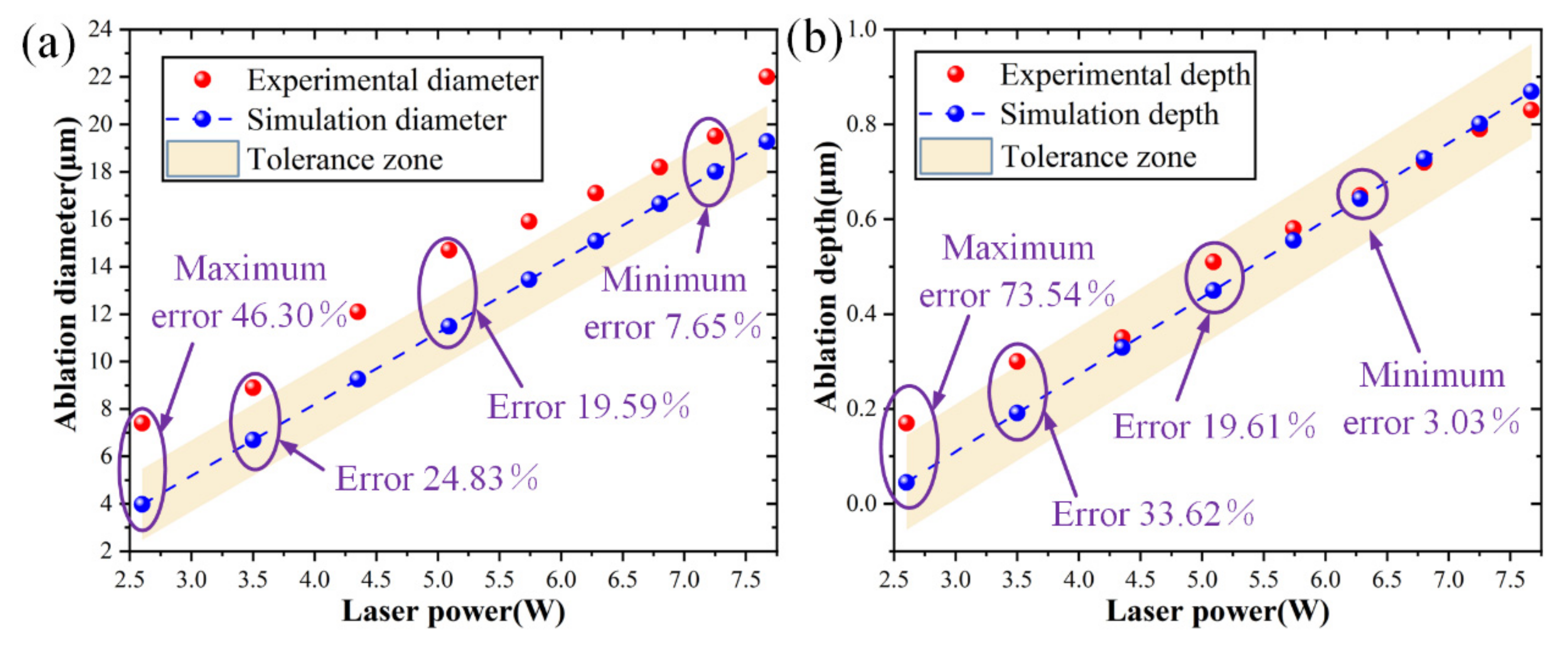
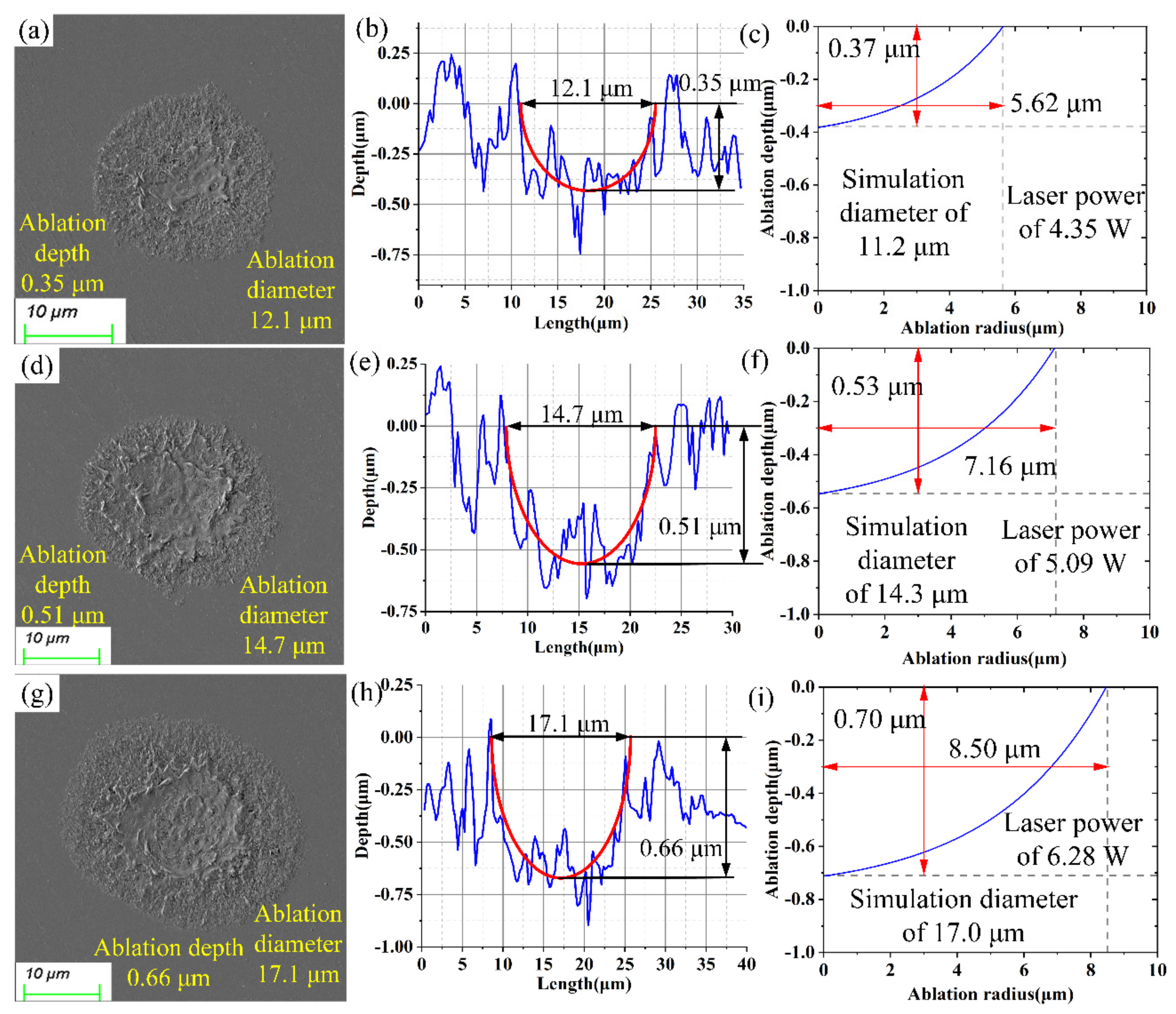
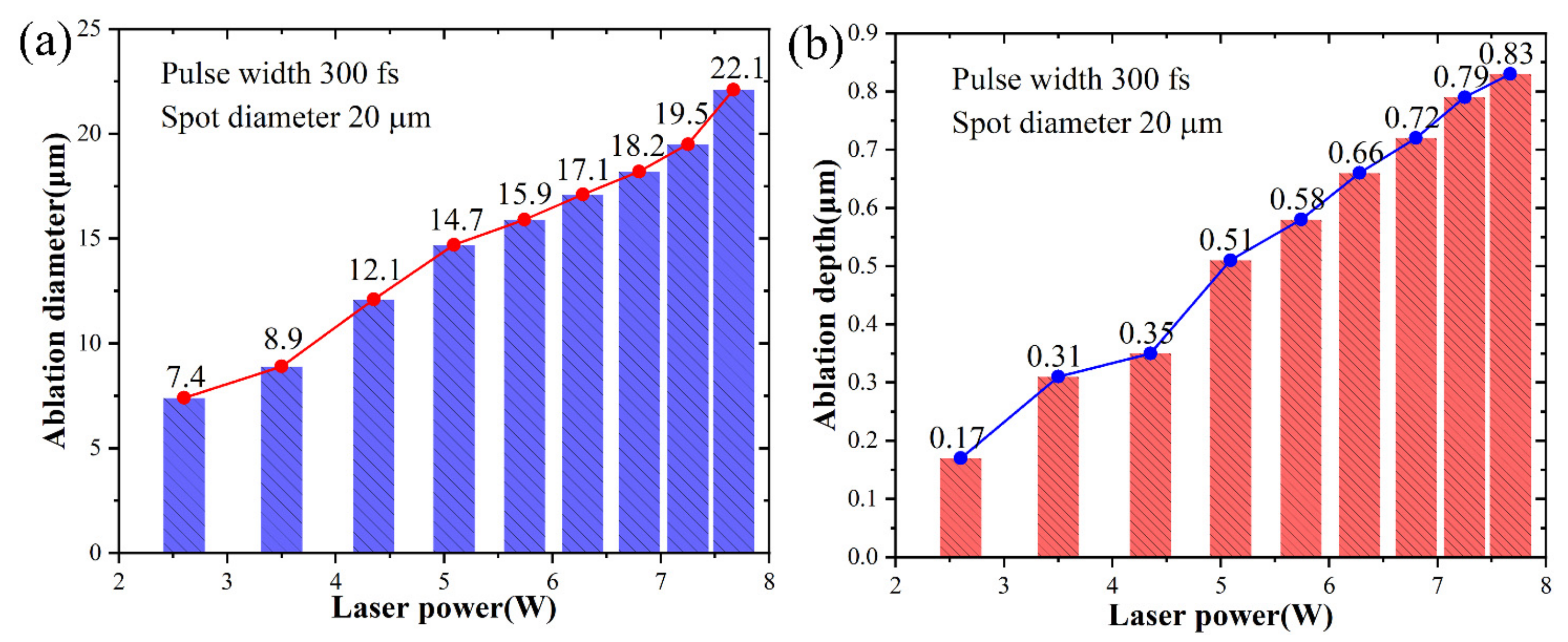


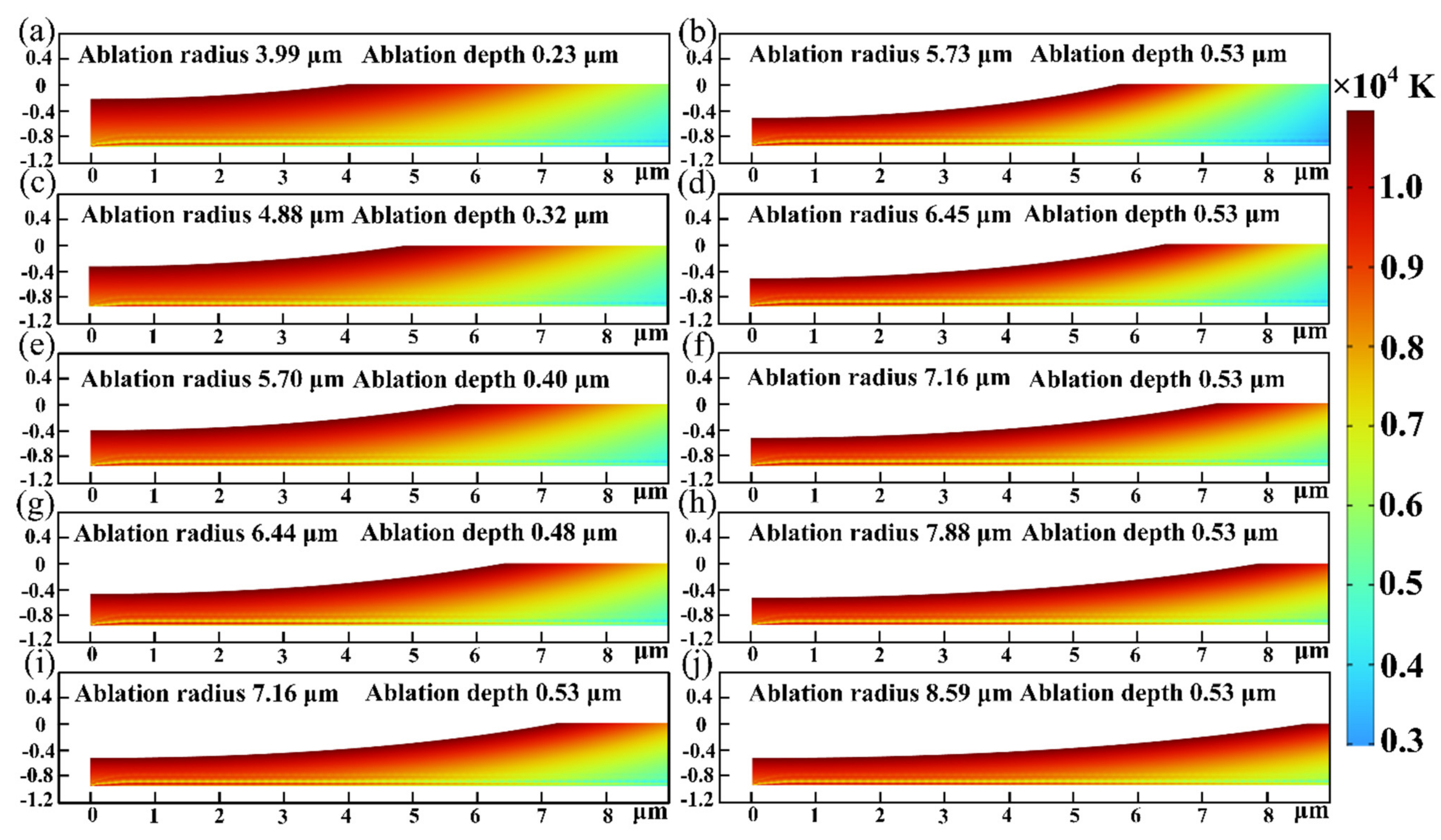
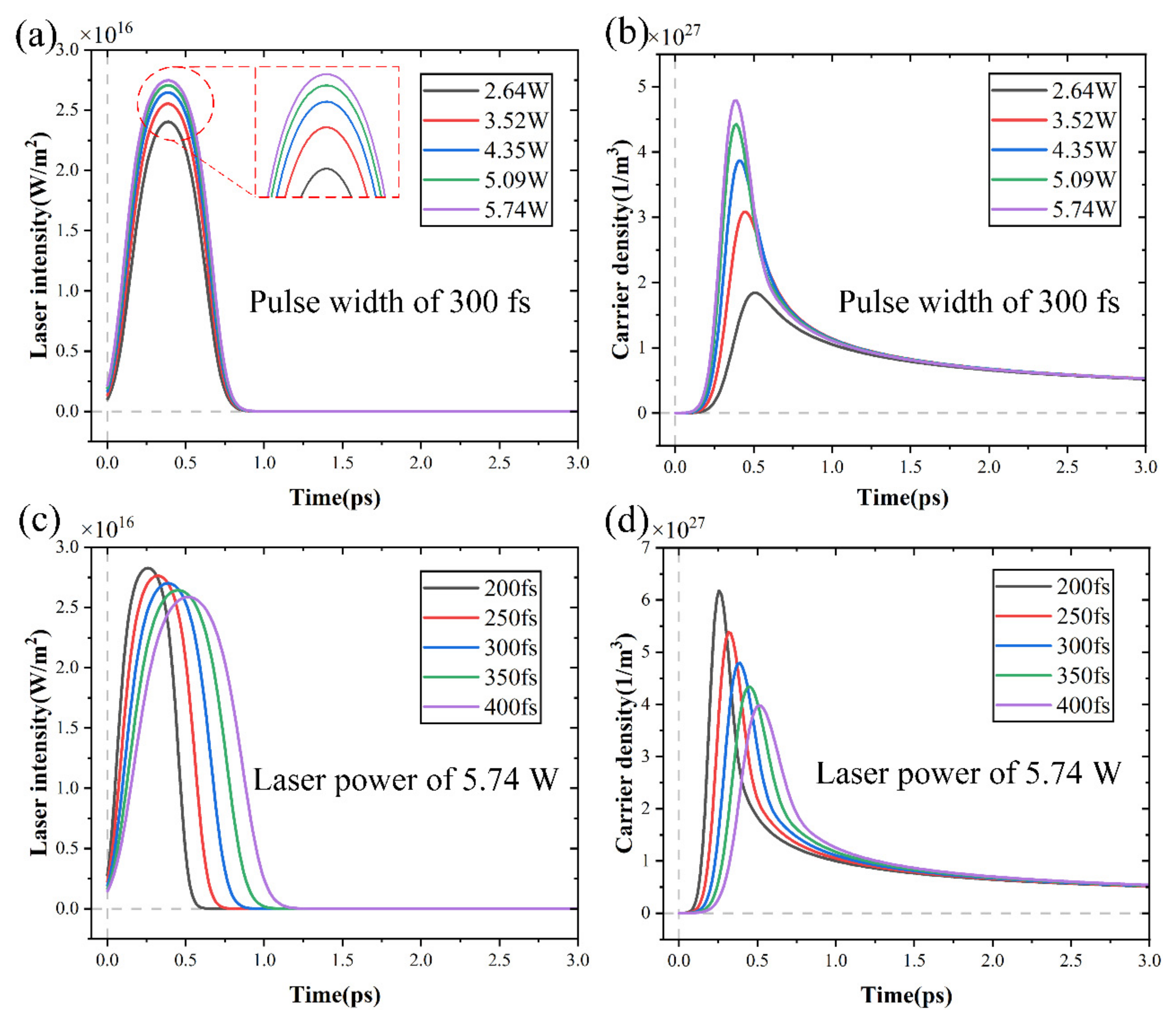
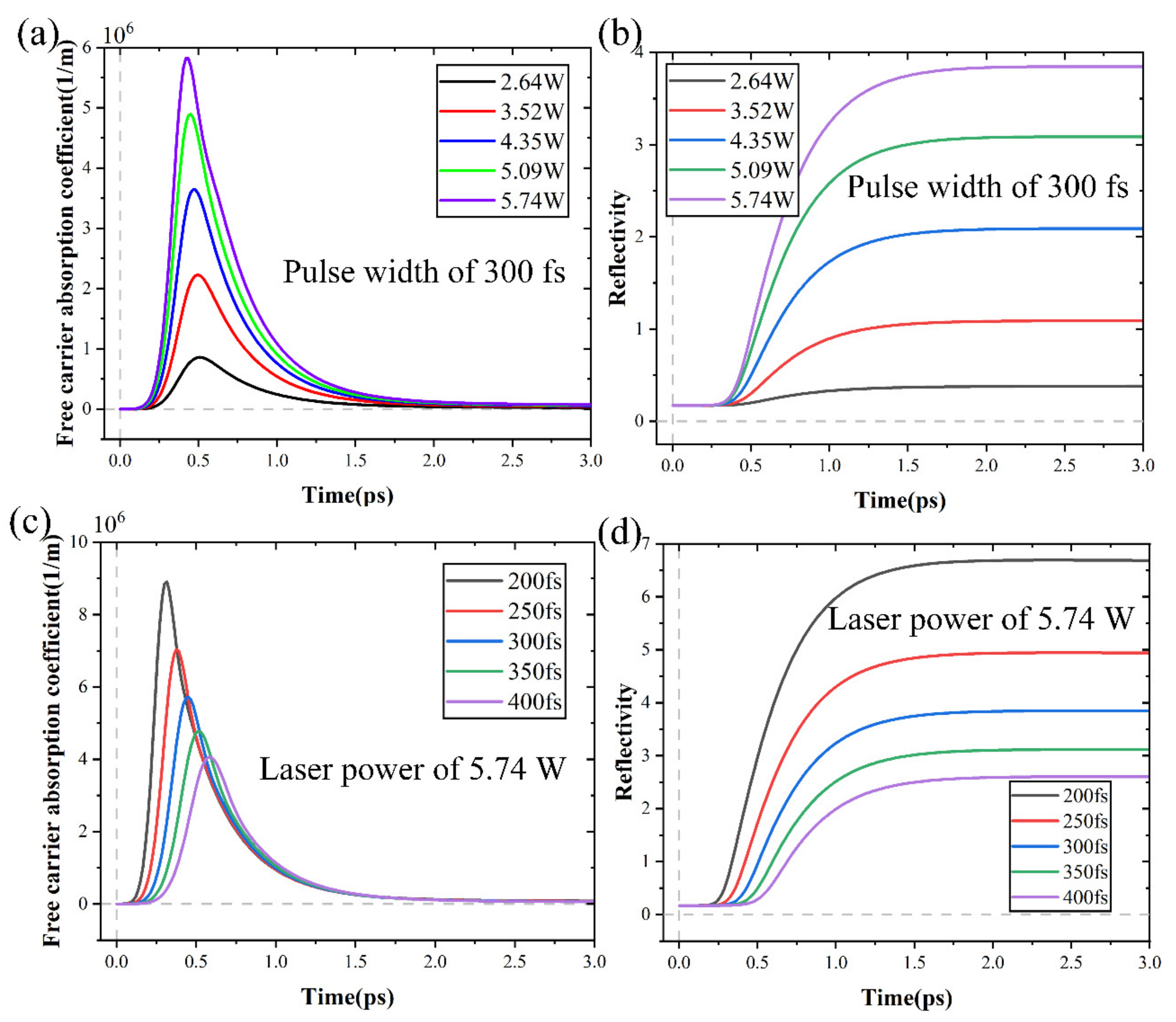
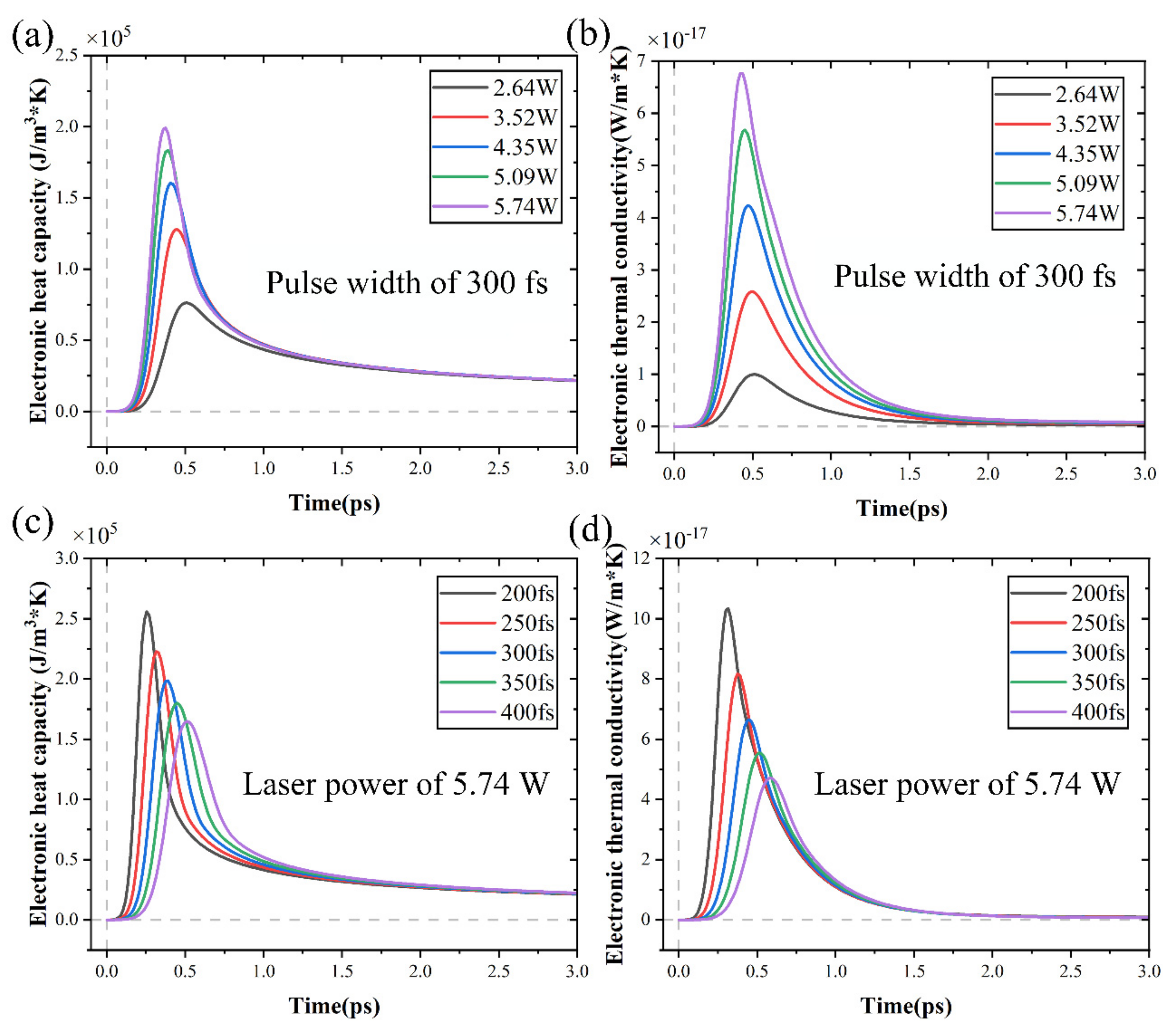
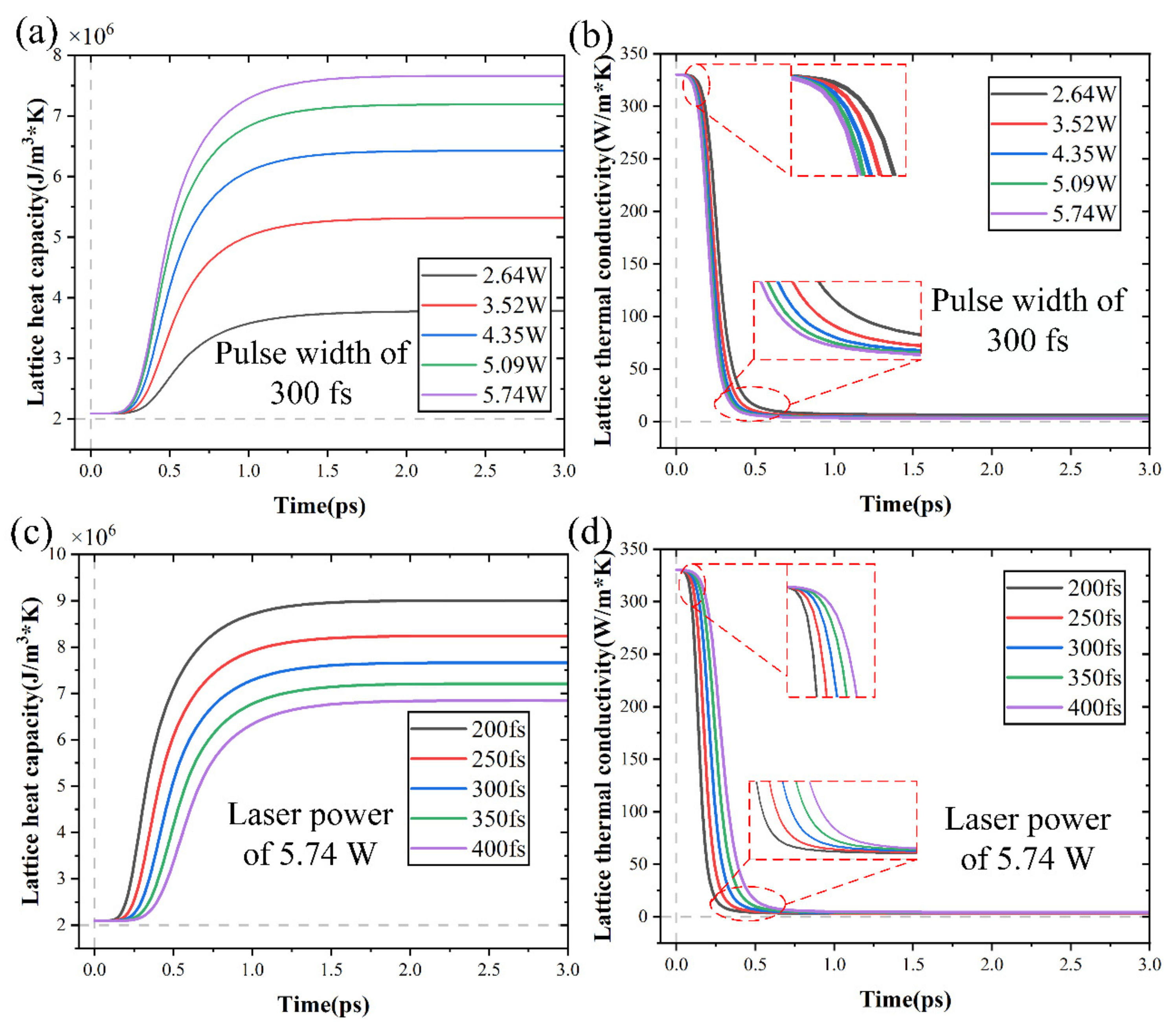
| Parameters | Values |
|---|---|
| Maximum power | 7.67 W |
| Power stability | 0.12% |
| Laser wavelength | 1030 nm |
| Pulse width | 300 fs |
| Temperature | 21 °C |
Disclaimer/Publisher’s Note: The statements, opinions and data contained in all publications are solely those of the individual author(s) and contributor(s) and not of MDPI and/or the editor(s). MDPI and/or the editor(s) disclaim responsibility for any injury to people or property resulting from any ideas, methods, instructions or products referred to in the content. |
© 2024 by the authors. Licensee MDPI, Basel, Switzerland. This article is an open access article distributed under the terms and conditions of the Creative Commons Attribution (CC BY) license (https://creativecommons.org/licenses/by/4.0/).
Share and Cite
Hua, Y.; Zhang, Z.; Du, J.; Liang, X.; Zhang, W.; Cai, Y.; Wang, Q. Experimental and Simulation Research on Femtosecond Laser Induced Controllable Morphology of Monocrystalline SiC. Micromachines 2024, 15, 573. https://doi.org/10.3390/mi15050573
Hua Y, Zhang Z, Du J, Liang X, Zhang W, Cai Y, Wang Q. Experimental and Simulation Research on Femtosecond Laser Induced Controllable Morphology of Monocrystalline SiC. Micromachines. 2024; 15(5):573. https://doi.org/10.3390/mi15050573
Chicago/Turabian StyleHua, Yang, Zhenduo Zhang, Jiyu Du, Xiaoliang Liang, Wei Zhang, Yukui Cai, and Quanjing Wang. 2024. "Experimental and Simulation Research on Femtosecond Laser Induced Controllable Morphology of Monocrystalline SiC" Micromachines 15, no. 5: 573. https://doi.org/10.3390/mi15050573





